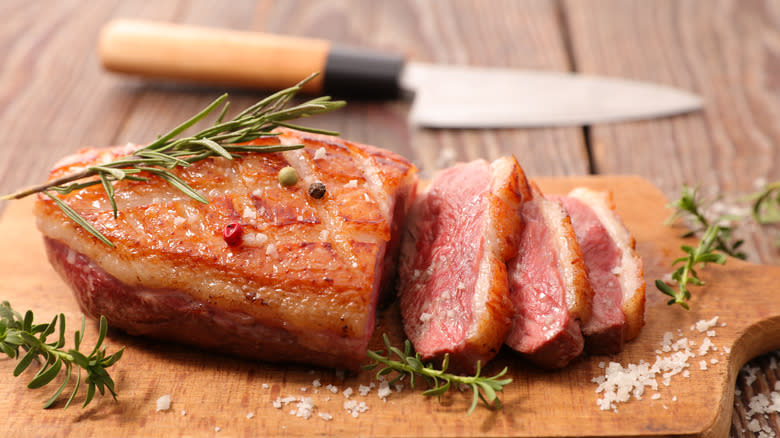The Extra Steps Martha Stewart Takes To Ensure Crispy Skin On Duck Breast

When it comes to culinary prowess, few can rival the expertise of the legendary Martha Stewart. One culinary feat that Stewart has mastered is a perfectly crispy skin on duck breast. Martha's secret? A meticulously crafted three-step process that ensures that delightful crunch with each bite.
According to a clip shared on her YouTube channel, Stewart's journey to crispy duck skin begins with the proper preparation. Her first step involves tenderizing the duck with a Jaccard tenderizer that punctures small holes into the meat, allowing it to cook evenly while retaining more flavor and juices. This also helps to maximize the additional steps Stewart follows.
Next, she lets the duck breast rest on a bed of salt, skin side down, for an hour. This seemingly simple act plays a pivotal role in the quest for crispiness. The salt draws out moisture from the skin, creating a dry surface. This dryness is essential because when moisture inhibits the crisping process, undesirable results are likely. By drying out the skin, we set the stage for the subsequent steps that will ultimately yield that coveted crunch.
Read more: 15 Different Ways To Cook Fish
Chill And Sear The Duck Skin

After the salt bed, Martha Stewart takes another ingenious step by chilling the duck breast on ice, skin side down, for approximately 25 minutes. This process helps keep the duck fat from melting too rapidly as it cooks. As the duck breast chills, the fat firms up, creating a barrier that prevents it from rendering too quickly. Combined, these steps prepare the duck skin to become perfectly crispy as it sears.
The final step in Stewart's crispy duck skin mastery involves starting with a cold pan when it's time to sear the duck. Contrary to the instinct of heating the pan first, beginning with a cold pan is key to achieving that crispy, golden-brown skin. The cold pan allows the fat to slowly melt and render, gradually crisping up the skin to perfection. This gentle approach ensures that the skin crisps evenly and retains its texture without burning or becoming overly dry.
Read the original article on Tasting Table.

